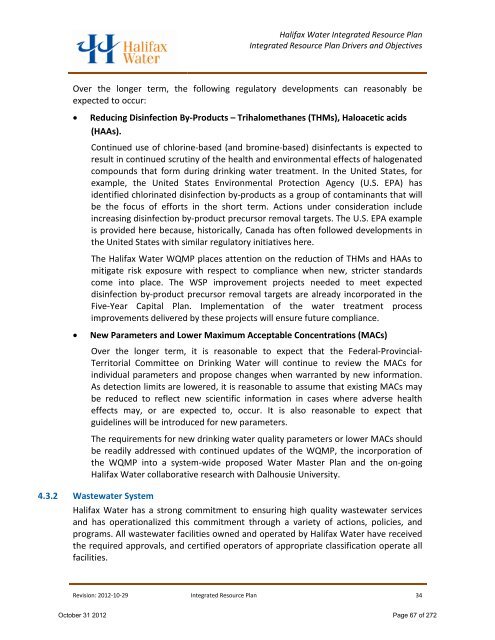volume 1 - Halifax Regional Municipality
volume 1 - Halifax Regional Municipality
volume 1 - Halifax Regional Municipality
Create successful ePaper yourself
Turn your PDF publications into a flip-book with our unique Google optimized e-Paper software.
<strong>Halifax</strong> Water Integrated Resource Plan<br />
Integrated Resource Plan Drivers and Objectives<br />
Over the longer term, the following regulatory developments can reasonably be<br />
expected to occur:<br />
• Reducing Disinfection By-Products – Trihalomethanes (THMs), Haloacetic acids<br />
(HAAs).<br />
Continued use of chlorine-based (and bromine-based) disinfectants is expected to<br />
result in continued scrutiny of the health and environmental effects of halogenated<br />
compounds that form during drinking water treatment. In the United States, for<br />
example, the United States Environmental Protection Agency (U.S. EPA) has<br />
identified chlorinated disinfection by-products as a group of contaminants that will<br />
be the focus of efforts in the short term. Actions under consideration include<br />
increasing disinfection by-product precursor removal targets. The U.S. EPA example<br />
is provided here because, historically, Canada has often followed developments in<br />
the United States with similar regulatory initiatives here.<br />
The <strong>Halifax</strong> Water WQMP places attention on the reduction of THMs and HAAs to<br />
mitigate risk exposure with respect to compliance when new, stricter standards<br />
come into place. The WSP improvement projects needed to meet expected<br />
disinfection by-product precursor removal targets are already incorporated in the<br />
Five-Year Capital Plan. Implementation of the water treatment process<br />
improvements delivered by these projects will ensure future compliance.<br />
• New Parameters and Lower Maximum Acceptable Concentrations (MACs)<br />
Over the longer term, it is reasonable to expect that the Federal-Provincial-<br />
Territorial Committee on Drinking Water will continue to review the MACs for<br />
individual parameters and propose changes when warranted by new information.<br />
As detection limits are lowered, it is reasonable to assume that existing MACs may<br />
be reduced to reflect new scientific information in cases where adverse health<br />
effects may, or are expected to, occur. It is also reasonable to expect that<br />
guidelines will be introduced for new parameters.<br />
The requirements for new drinking water quality parameters or lower MACs should<br />
be readily addressed with continued updates of the WQMP, the incorporation of<br />
the WQMP into a system-wide proposed Water Master Plan and the on-going<br />
<strong>Halifax</strong> Water collaborative research with Dalhousie University.<br />
4.3.2 Wastewater System<br />
<strong>Halifax</strong> Water has a strong commitment to ensuring high quality wastewater services<br />
and has operationalized this commitment through a variety of actions, policies, and<br />
programs. All wastewater facilities owned and operated by <strong>Halifax</strong> Water have received<br />
the required approvals, and certified operators of appropriate classification operate all<br />
facilities.<br />
Revision: 2012-10-29 Integrated Resource Plan 34<br />
October 31 2012 Page 67 of 272
















